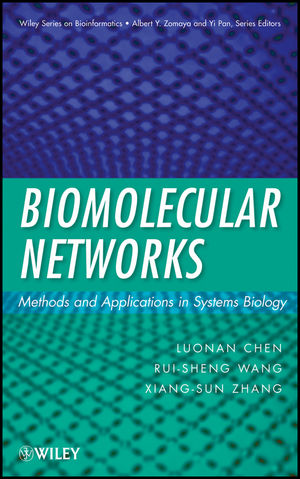Biomolecular Networks: Methods and Applications in Systems BiologyISBN: 978-0-470-24373-2
Hardcover
420 pages
July 2009
 |
||||||
ACKNOWLEDGMENTS.
LIST OF ILLUSTRATIONS.
ACRONYMS.
1 Introduction.
1.1 Basic Concepts in Molecular Biology.
1.2 Biomolecular Networks in Cells.
1.3 Network Systems Biology.
1.4 About This Book.
I GENE NETWORKS.
2 Transcription Regulation: Networks and Models.
2.1 Transcription Regulation and Gene Expression.
2.2 Networks in Transcription Regulation.
2.3 Nonlinear Models Based on Biochemical Reactions.
2.4 Integrated Models for Regulatory Networks.
2.5 Summary.
3 Reconstruction of Gene Regulatory Networks.
3.1 Mathematical Models of Gene Regulatory Network.
3.2 Reconstructing Gene Regulatory Networks.
3.3 Inferring Gene Networks from Multiple Datasets.
3.4 Gene Network-Based Drug Target Identification.
3.5 Summary.
4 Inference of Transcriptional Regulatory Networks.
4.1 Predicting TF Binding Sites and Promoters.
4.2 Inference of Transcriptional Interactions.
4.3 Identifying Combinatorial Regulations of TFs.
4.4 Inferring Cooperative Regulatory Networks.
4.5 Prediction of Transcription Factor Activity.
4.6 Summary.
II PROTEIN INTERACTION NETWORKS.
5 Prediction of Protein–Protein Interactions.
5.1 Experimental Protein–Protein Interactions.
5.2 Prediction of Protein–Protein Interactions.
5.3 Protein Interaction Prediction Based on Multidomain Pairs.
5.4 Domain Interaction Prediction Methods.
5.5 Summary.
6 Topological Structure of Biomolecular Networks.
6.1 Statistical Properties of Biomolecular Networks.
6.2 Evolution of Protein Interaction Networks.
6.3 Hubs, Motifs, and Modularity in Biomolecular Networks.
6.4 Explorative Roles of Hubs and Network Motifs.
6.5 Modularity Evaluation of Biomolecular Networks.
6.6 Summary.
7 Alignment of Biomolecular Networks.
7.1 Biomolecular Networks from Multiple Species.
7.2 Pairwise Alignment of Biomolecular Networks.
7.3 Network Alignment by Mathematical Programming.
7.4 Multiple Alignment of Biomolecular Networks.
7.5 Subnetwork and Pathway Querying.
7.6 Summary.
8 Network-Based Prediction of Protein Function.
8.1 Protein Function and Annotation.
8.2 Protein Functional Module Detection.
8.3 Functional Linkage for Protein Function Annotation.
8.4 Protein Function Prediction from High-Throughput Data.
8.5 Function Annotation Methods for Domains.
8.6 Summary.
III METABOLIC NETWORKS AND SIGNALING NETWORKS.
9 Metabolic Networks: Analysis, Reconstruction, and Application.
9.1 Cellular Metabolism and Metabolic Pathways.
9.2 Metabolic Network Analysis and Modeling.
9.3 Reconstruction of Metabolic Networks.
9.4 Drug Target Detection in Metabolic Networks.
9.5 Summary.
10 Signaling Networks: Modeling and Inference.
10.1 Signal Transduction in Cellular Systems.
10.2 Modeling of Signal Transduction Pathways.
10.3 Inferring Signaling Networks from High-Throughput Data.
10.4 Inferring Signaling Networks by Linear Programming.
10.5 Inferring Signaling Networks from Experimental Evidence.
10.6 Summary.
11 Other Topics and New Trends.
11.1 Network-Based Protein Structural Analysis.
11.2 Integration of Biomolecular Networks.
11.3 Posttranscriptional Regulation of Noncoding RNAs.
11.4 Biomolecular Interactions and Human Diseases.
11.5 Summary.
REFERENCES.
INDEX.



